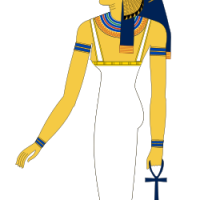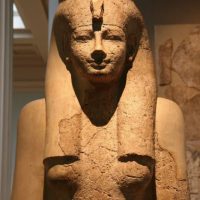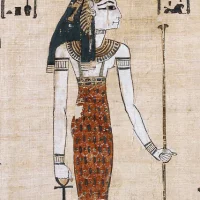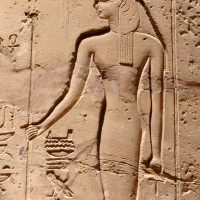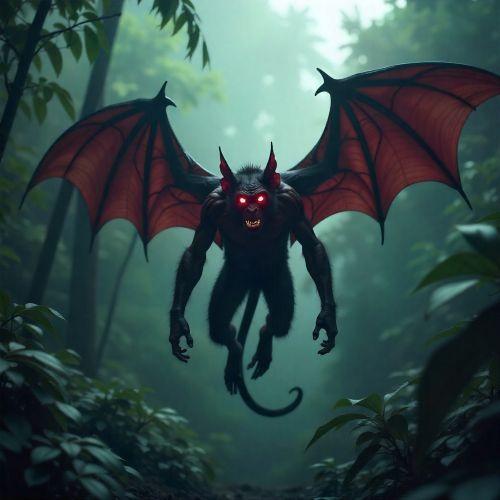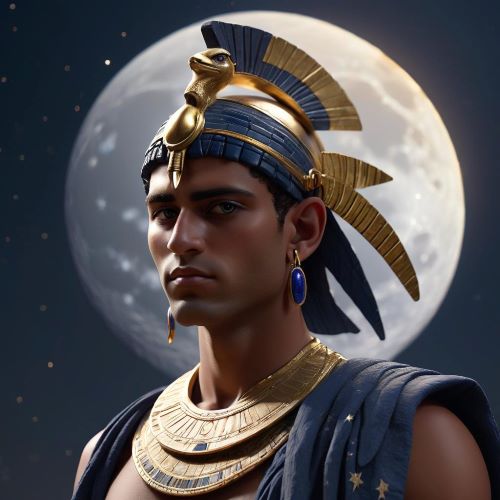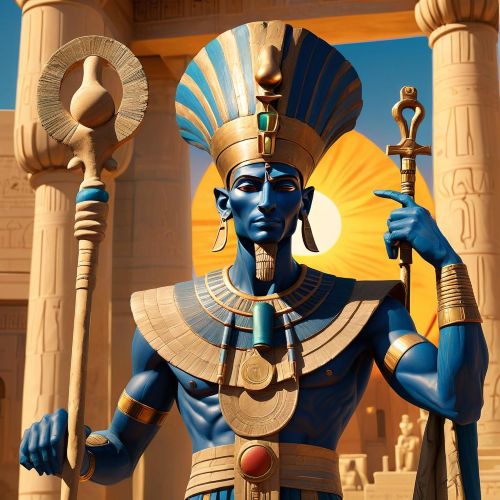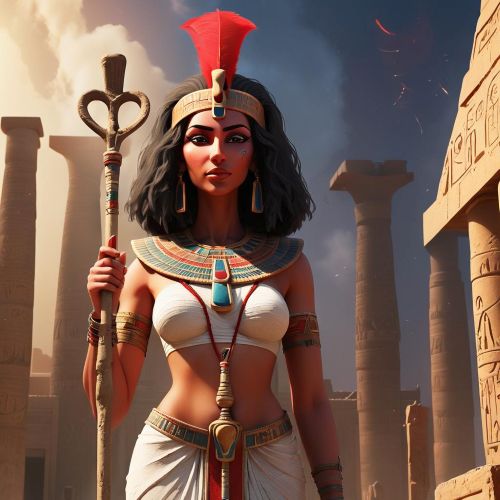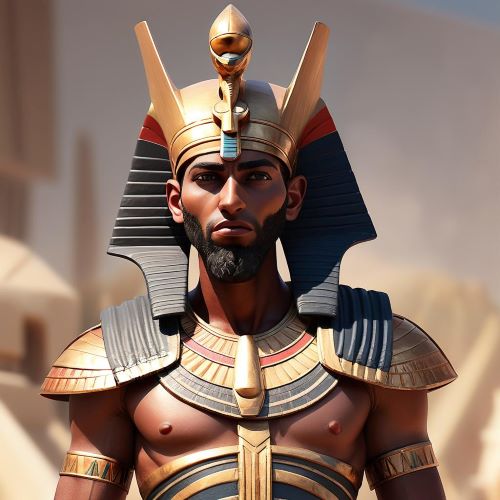Mut : The Mother Goddess
Listen
At a glance
| Description | |
|---|---|
| Origin | Egyptian Mythology |
| Classification | Gods |
| Family Members | Amun (Husband), Khonsu (Son) |
| Region | Egypt |
| Associated With | Motherhood, Protection |
Mut
Introduction
Mut, whose name literally means “Mother” in ancient Egyptian, was one of the most powerful and enduring goddesses in the Egyptian pantheon. Originally a local Theban deity, she rose to national prominence during the New Kingdom when Thebes became Egypt’s political and spiritual capital. Mut embodied motherhood, creation, and divine authority, serving as the cosmic mother from whom all life emerged. She was worshipped as the consort of Amun, the chief god of Thebes, and together with their son Khonsu, the moon god, they formed the Theban Triad—a central focus of worship at Karnak. Mut represented the archetype of the universal mother, encompassing the qualities of protector, nurturer, and queen, symbolizing both the gentleness of creation and the fierce guardianship of divine order.
Physical Traits
In Egyptian art, Mut is typically portrayed as a majestic woman wearing the vulture headdress—a sacred emblem of motherhood and royal protection. Atop the headdress, she often bore the double crown of Upper and Lower Egypt, symbolizing her dominion over the unified kingdom. She was also shown holding the ankh, representing eternal life, and a papyrus scepter, denoting authority and regeneration.
Her vulture symbolism was particularly meaningful in Egyptian belief, as vultures were thought to reproduce without males and to fiercely protect their young. This idea linked Mut to self-generation and divine motherhood. In some depictions, Mut takes on the head of a lioness, revealing her fierce and protective side, closely related to warrior goddesses like Sekhmet and Bastet. Occasionally, she is shown with outstretched wings, signifying her role as a divine guardian embracing all of creation.
During the Ptolemaic period, more complex representations appeared, such as Mut-Isis-Nekhbet—a composite goddess combining elements of Mut, Isis, and the vulture goddess Nekhbet. In this form, she might bear three heads (human, lioness, and vulture) to express her creative, destructive, and protective powers. Whether depicted as nurturing or formidable, Mut’s imagery always reflected balance between life-giving compassion and divine authority.
Family
Mut’s family relationships were central to her mythological significance. She was revered as the wife of Amun, the hidden god of Thebes, and mother of Khonsu, the lunar deity. This triad—Amun, Mut, and Khonsu—became the heart of Theban religious devotion, with great festivals celebrating their unity. The annual Opet Festival, for instance, honored Mut’s role as divine mother and queen, when her statue was paraded from her temple at Karnak to Luxor Temple alongside that of Amun.
Older traditions suggest that Mut existed before creation itself, arising from the waters of Nun, the primordial abyss. This made her a self-created goddess—“She Who Gave Birth but Was Herself Not Born.” Some myths even describe her as the mother of all gods and humans, emphasizing her universal motherhood. Mut replaced Amun’s earlier consort, Amaunet, during the Middle Kingdom, reflecting the shifting religious importance of Thebes. In royal ideology, pharaohs often claimed descent from Mut to legitimize their divine right to rule, and queens like Hatshepsut portrayed themselves as her earthly embodiments, linking political power to divine maternity.
Other names
Mut’s name, which simply means “Mother,” was both a title and a sacred identity. Throughout Egyptian history, she was known by several epithets that expressed her vast powers and roles. She was called “Mother of the Gods,” “Queen of the Goddesses,” and “Lady of Heaven,” titles that underscored her status as the supreme maternal force of the cosmos.
She was also known as “Mistress of the Two Lands,” reflecting her authority over all Egypt, and “Eye of Ra,” linking her to the solar deity’s fiery and protective aspects. This connection to Ra also made her “Mother of the Sun in Whom He Rises,” suggesting her role in cosmic renewal and light’s daily rebirth. Another of her titles, “She Who Giveth Birth, But Was Herself Not Born,” encapsulates her role as a self-generating creative power—one of the rare divine beings who emerged without origin.
Mut’s worship sometimes merged her identity with other great goddesses such as Isis, Hathor, and Sekhmet. This syncretism reflected the Egyptian belief that all divine mothers were manifestations of a single primordial feminine principle, embodied most completely in Mut.
Powers and Abilities
Mut was a goddess of immense power, revered as both a life-giver and protector. As the divine mother, she was believed to have created the world from the watery chaos of Nun. Her role encompassed creation, fertility, renewal, and guardianship over the pharaoh and the kingdom. In her protective aspect, she shielded Egypt from chaos and evil forces, ensuring stability and harmony in the cosmic order known as Ma’at.
She possessed regenerative power, often described as “She Who Becomes Young Again.” This idea linked her with the lunar cycles of Khonsu, her son, representing rebirth and rejuvenation. Mut’s fierce aspects surfaced in her lioness-headed forms, where she embodied righteous wrath and destruction against those who threatened the balance of creation.
Her power extended into royal ideology, as pharaohs invoked her name for legitimacy and divine protection. Many rulers dedicated temples and offerings to Mut, acknowledging her role as the mother of kings. Her worshippers believed she could heal illnesses, grant fertility, and provide comfort to the distressed. In the afterlife, Mut appeared as a savior goddess who guided souls through the underworld and offered spiritual rebirth.
As a self-created deity who could embody both male and female principles, Mut represented the totality of divine energy. She absorbed the traits of other goddesses like Wadjet and Menhit, symbolizing her comprehensive dominion over creation and destruction alike.
Modern Day Influence
Though the worship of Mut ended with the decline of ancient Egyptian religion, her legacy remains visible in archaeology, spirituality, and modern culture. Her temple complex within Karnak—the Precinct of Mut—still stands as one of the most significant sacred sites in Thebes. Archaeological excavations there have revealed hundreds of statues, inscriptions, and ritual artifacts dedicated to her, underscoring the vastness of her ancient cult.
In the Greco-Roman period, Mut’s identity merged with that of Hera, the Greek goddess of marriage and motherhood, showing how her symbolism transcended Egyptian borders. Artists and writers of later eras often depicted her as an emblem of divine femininity and maternal strength.
Today, Mut’s archetype continues to influence modern interpretations of goddess spirituality. She represents empowerment, protection, and the sacred essence of motherhood in contemporary pagan and feminist movements. Her story resonates in discussions of divine balance, gender duality, and the enduring power of creation. In popular culture and modern scholarship, Mut stands as a timeless reminder of the ancient world’s reverence for maternal divinity and cosmic order.
Related Images
Source
Ancient Egypt Online. (2020). Mut. Retrieved from https://ancientegyptonline.co.uk/mut/
Britannica. (1998). Mut: Description & Story. Retrieved from https://www.britannica.com/topic/Mut
Cairo Top Tours. (2023). Goddess Mut | Gods in Ancient Egypt. Retrieved from https://www.cairotoptours.com/Egypt-Travel-Guide/Gods-of-Ancient-Egypt/Mut
Handbook of Egyptian Mythology. (n.d.). Retrieved from https://dn790009.ca.archive.org/0/items/handbook-of-egyptian-mythology/handbook%20of%20egyptian%20mythology.pdf
Mark, J. J. (2016). Egyptian Gods – The Complete List. World History Encyclopedia. Retrieved from https://www.worldhistory.org/article/885/egyptian-gods—the-complete-list/
Mut. (2002, September 29). In Wikipedia. Retrieved from https://en.wikipedia.org/wiki/Mut
Mut – Students. (n.d.). Britannica Kids. Retrieved from https://kids.britannica.com/students/article/Mut/312377
The Egypt Museum. (2025). Goddess Mut. Retrieved from https://egypt-museum.com/mut/
Frequently Asked Questions
What is lorem Ipsum?
I am text block. Click edit button to change this text. Lorem ipsum dolor sit amet, consectetur adipiscing elit. Ut elit tellus, luctus nec ullamcorper mattis, pulvinar dapibus leo.
What is lorem Ipsum?
I am text block. Click edit button to change this text. Lorem ipsum dolor sit amet, consectetur adipiscing elit. Ut elit tellus, luctus nec ullamcorper mattis, pulvinar dapibus leo.
What is lorem Ipsum?
I am text block. Click edit button to change this text. Lorem ipsum dolor sit amet, consectetur adipiscing elit. Ut elit tellus, luctus nec ullamcorper mattis, pulvinar dapibus leo.
What is lorem Ipsum?
I am text block. Click edit button to change this text. Lorem ipsum dolor sit amet, consectetur adipiscing elit. Ut elit tellus, luctus nec ullamcorper mattis, pulvinar dapibus leo.
What is lorem Ipsum?
I am text block. Click edit button to change this text. Lorem ipsum dolor sit amet, consectetur adipiscing elit. Ut elit tellus, luctus nec ullamcorper mattis, pulvinar dapibus leo.



